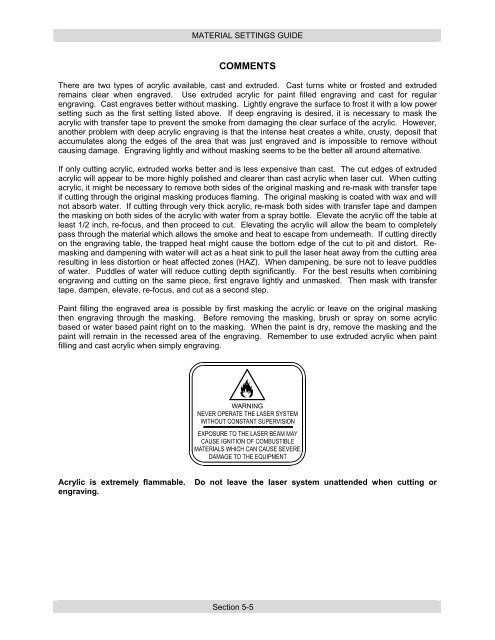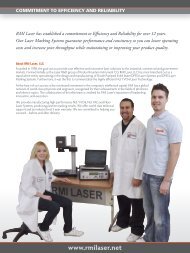M-360 / V-460 - Engraving Systems Support
M-360 / V-460 - Engraving Systems Support
M-360 / V-460 - Engraving Systems Support
- No tags were found...
You also want an ePaper? Increase the reach of your titles
YUMPU automatically turns print PDFs into web optimized ePapers that Google loves.
MATERIAL SETTINGS GUIDECOMMENTSThere are two types of acrylic available, cast and extruded. Cast turns white or frosted and extrudedremains clear when engraved. Use extruded acrylic for paint filled engraving and cast for regularengraving. Cast engraves better without masking. Lightly engrave the surface to frost it with a low powersetting such as the first setting listed above. If deep engraving is desired, it is necessary to mask theacrylic with transfer tape to prevent the smoke from damaging the clear surface of the acrylic. However,another problem with deep acrylic engraving is that the intense heat creates a white, crusty, deposit thataccumulates along the edges of the area that was just engraved and is impossible to remove withoutcausing damage. <strong>Engraving</strong> lightly and without masking seems to be the better all around alternative.If only cutting acrylic, extruded works better and is less expensive than cast. The cut edges of extrudedacrylic will appear to be more highly polished and clearer than cast acrylic when laser cut. When cuttingacrylic, it might be necessary to remove both sides of the original masking and re-mask with transfer tapeif cutting through the original masking produces flaming. The original masking is coated with wax and willnot absorb water. If cutting through very thick acrylic, re-mask both sides with transfer tape and dampenthe masking on both sides of the acrylic with water from a spray bottle. Elevate the acrylic off the table atleast 1/2 inch, re-focus, and then proceed to cut. Elevating the acrylic will allow the beam to completelypass through the material which allows the smoke and heat to escape from underneath. If cutting directlyon the engraving table, the trapped heat might cause the bottom edge of the cut to pit and distort. Remaskingand dampening with water will act as a heat sink to pull the laser heat away from the cutting arearesulting in less distortion or heat affected zones (HAZ). When dampening, be sure not to leave puddlesof water. Puddles of water will reduce cutting depth significantly. For the best results when combiningengraving and cutting on the same piece, first engrave lightly and unmasked. Then mask with transfertape, dampen, elevate, re-focus, and cut as a second step.Paint filling the engraved area is possible by first masking the acrylic or leave on the original maskingthen engraving through the masking. Before removing the masking, brush or spray on some acrylicbased or water based paint right on to the masking. When the paint is dry, remove the masking and thepaint will remain in the recessed area of the engraving. Remember to use extruded acrylic when paintfilling and cast acrylic when simply engraving.Acrylic is extremely flammable. Do not leave the laser system unattended when cutting orengraving.Section 5-5





